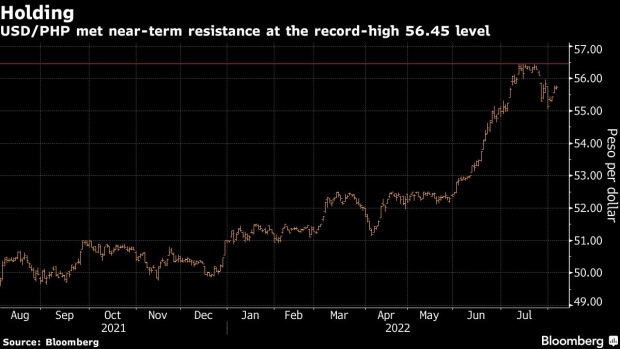Aug 7, 2022
Bulls Bet Philippine Peso Will Extend Rebound From Record Low
, Bloomberg News

(Bloomberg) -- The Philippine peso’s rebound from a record low is set to gain momentum amid expectations of higher remittances and as lower oil prices curb import costs.
The peso is seen rising to 54 against the dollar by end-December, about 2% higher than Friday’s close, according to ING Groep NV, Scotiabank and Malayan Banking Bhd. It fell to a record low in July.
The currency is also likely to get a boost from the central bank’s resolve to keep tightening monetary policy to maintain an interest-rate buffer with the US. Traders this week will look forward to economic growth and trade data to gauge the peso’s trajectory as emerging-market currencies face pressure from aggressive Federal Reserve tightening.
“The worst is probably over for the peso,” said Michael Ricafort, chief economist at Rizal Commercial Banking Corp. in Manila. “While there will be volatility, and it could be extreme, supportive factors are coming into play, particularly remittances and the drop in global crude prices.”
The peso fell to a record low of 56.45 in July, declining along with other Asian emerging-markets currencies amid the dollar’s relentless rise. That may be set to change now, with the nation expecting to get 4% more remittances in 2022 than the $31.4 billion last year. Remittances typically rise in the second half of the year.
Easing oil prices will also help narrow the nation’s trade deficit, which widened to a record in May. The Philippines imports almost all its oil requirements, and higher import costs have boosted demand for dollars and added pressure on the peso.
“The energy import burden for the Philippines is expected to ease and that will help temper any negative sentiment on the peso,” said Yanxi Tan, a currency strategist at Maybank in Singapore.
Rate Support
Bangko Sentral ng Pilipinas has also pledged to continue to raise interest rates, with Governor Felipe Medalla signaling a minimum 25 basis-point hike this month. Officials have also drained billions of dollars from its foreign-exchange stockpile this year to support the peso.
“BSP’s policy normalization will be supportive of the peso in the coming months,” said Nicholas Mapa, senior economist at ING in Manila.
Here are the key economic data due this week:
- Monday, Aug. 8: Japan BoP current account balance, New Zealand 2-yr inflation expectations, Taiwan exports
- Tuesday, Aug. 9: Philippine GDP, trade balance, Australia consumer confidence, Malaysia industrial production
- Wednesday, Aug. 10: Thailand rate decision, China CPI and PPI
- Thursday, Aug. 11: Singapore GDP, Thai FX reserves
- Friday, Aug. 12: Taiwan GDP, Malaysia GDP, India inflation
©2022 Bloomberg L.P.





